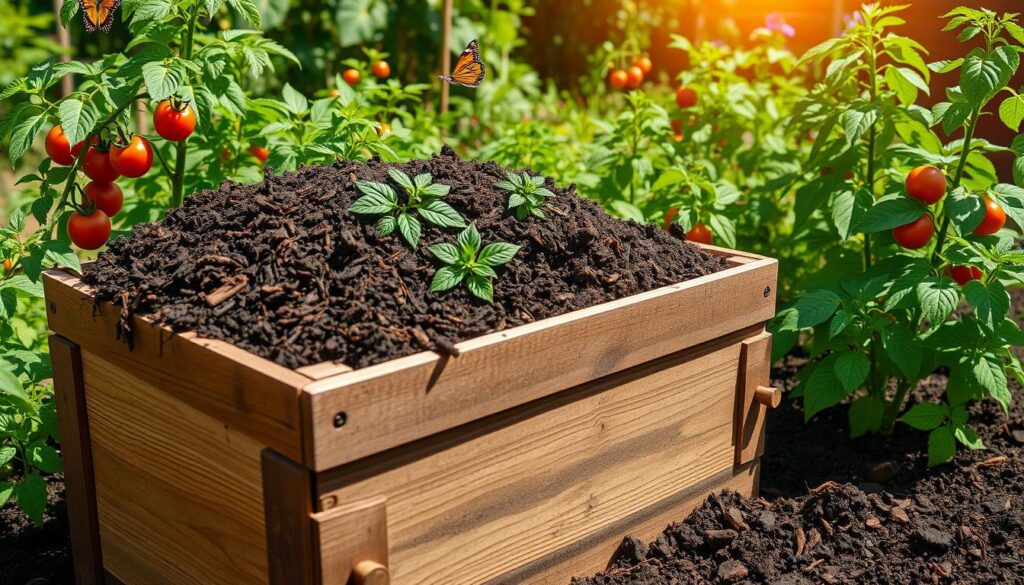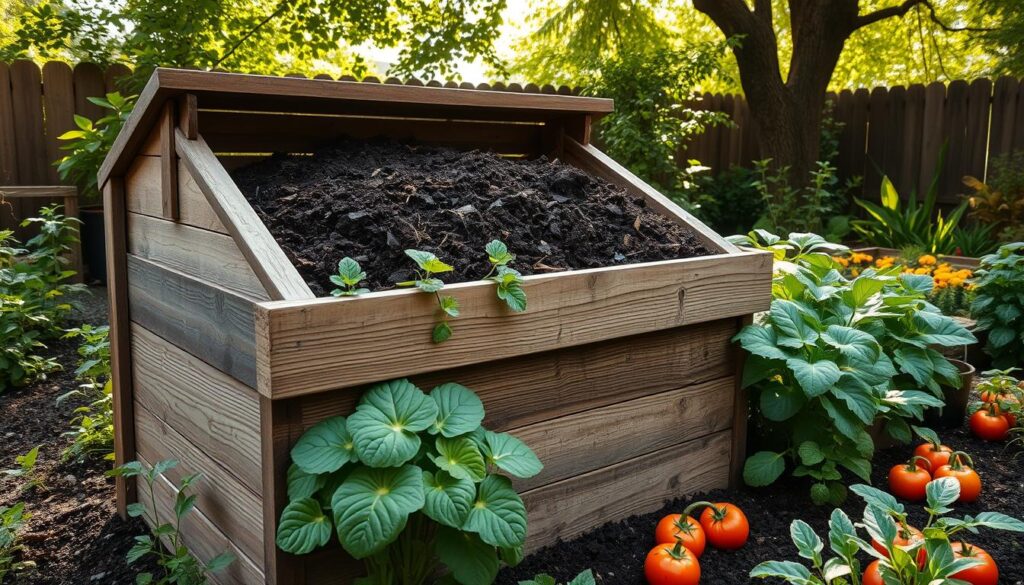I love gardening in my backyard and have found that the secret to growing great veggies is in the soil. Composting is a powerful tool to make your soil rich and healthy. In this guide, I’ll show you how to compost like a pro to get the best soil for your garden.
Key Takeaways
- Composting is essential for building nutrient-rich soil that supports healthy vegetable growth
- Compost improves soil structure, moisture retention, and nutrient availability
- A well-maintained compost pile can provide a continuous supply of organic matter for your garden
- Properly balancing green and brown materials is the key to successful composting
- Consistent monitoring and maintenance of the compost pile ensures optimal decomposition
Why Compost is Essential for Vegetable Gardens
Composting is a game-changer for your vegetable garden. It turns organic waste into a valuable soil amendment. This improves your garden’s soil structure, water-holding capacity, and nutrient content. By composting, you can make your vegetable patch healthier and more productive.
Benefits of Composting for Soil Health
Compost is full of essential nutrients like nitrogen, phosphorus, and potassium. It makes these nutrients available to your vegetables. It also improves soil structure, making it loose and well-draining.
By adding compost, your soil can hold more water. This means you don’t have to water as often. Learn more about composting at this link.
How Compost Improves Plant Growth
Compost does more than just improve soil health. It boosts plant growth and yields in your vegetable garden. It provides a steady supply of nutrients, supporting lush foliage and robust root systems.
Compost also helps plants handle environmental stresses better. This includes drought or heavy rainfall. It makes your plants more resilient.
| Benefit | Description |
|---|---|
| Nutrient-rich soil | Compost adds essential plant nutrients, including nitrogen, phosphorus, and potassium, to the soil. |
| Improved soil structure | Compost enhances soil texture, creating a loose, well-draining medium that supports root growth. |
| Increased water-holding capacity | The organic matter in compost helps the soil retain moisture, reducing the need for frequent watering. |
| Healthier plant growth | Nutrient-rich, well-structured soil supports robust root systems, lush foliage, and bountiful harvests. |
“Compost is the secret ingredient that transforms a good vegetable garden into a great one.”
Adding compost to your vegetable garden creates a thriving ecosystem. It supports the growth and health of your plants. Whether you’re new to gardening or experienced, composting is key to a healthy, productive garden.
How to Compost for a Healthier Vegetable Garden
Composting turns kitchen and yard waste into a soil amendment. It’s great for your vegetable garden. By following the composting process, you can make compost. This compost improves soil, holds water better, and feeds your plants.
To start, collect the right materials for your compost. You need a mix of “green” (nitrogen-rich) and “brown” (carbon-rich) organic matter. Green materials are fruit and veg scraps, coffee grounds, and grass clippings. Brown materials include dried leaves, shredded paper, and straw.
- Find a good spot for your compost bin or pile. It should be easy to get to and not in direct sunlight.
- Layer green and brown materials to balance your compost.
- Check the compost’s moisture often. It should be damp but not wet.
- Turn and aerate the compost with a garden fork or pitchfork. This speeds up decomposition.
With patience and care, you’ll have compost for your garden. This compost will make your soil healthier and help your plants grow better.
“Composting is one of the most effective ways to create a thriving, productive vegetable garden.”

Monitoring Moisture and Air Flow
Moisture and air flow are key for composting. Watch your compost pile’s moisture. It should be damp but not too wet. If it’s too dry, add water. If too wet, add brown materials like shredded paper or dry leaves.
Turning and Aerating the Compost
Turning and aerating the compost introduces oxygen. This speeds up decomposition. Use a garden fork or pitchfork to mix the materials. This ensures all parts get air.
Materials Needed for Composting
Composting is all about mixing “green” and “brown” materials. These help make compost that feeds your garden. Let’s look at what green and brown materials you can use and the right mix for a good compost pile.
Green and Brown Materials for a Balanced Compost Pile
Green materials, or “nitrogen-rich” ones, add moisture and nitrogen. They help break down the compost. Here are some green materials:
- Fruit and vegetable scraps
- Grass clippings
- Manure from herbivorous animals
- Coffee grounds and tea leaves
Brown materials, or “carbon-rich” ones, give structure and balance moisture. Here are some brown materials:
- Dried leaves and shredded paper
- Straw and hay
- Shredded cardboard and newspaper
- Wood chips and sawdust
The best mix is about 3 parts brown to 1 part green. This mix makes compost that’s full of nutrients for your garden.
“A well-balanced compost pile is the foundation for a thriving vegetable garden. By carefully selecting the right composting materials, you can create a nutrient-rich soil amendment that will help your plants reach their full potential.”
Setting up a Compost Bin or Pile
Composting turns kitchen and garden waste into rich soil for your garden. You can use a compost bin or make a pile. Here’s how to set it up for the best results.
First, pick a good spot for your compost. It should be near your garden or kitchen. Make sure it’s on well-draining soil and gets some shade. This helps keep the compost moist.
Next, decide on the size of your compost area. Aim for a 3×3 feet space. This size is perfect for breaking down waste quickly. If space is tight, a smaller bin works too.
- Get the materials you need, like a compost bin or materials for a pile.
- Start with a base layer of brown materials like dead leaves or shredded paper. Then add green materials like fruit and veg scraps.
- Make sure the layers are even and balanced between brown and green.
- Top it off with straw or dry leaves to keep it moist and smell-free.
By following these steps, you’ll have a great composting setup. It will turn your waste into valuable compost for your garden.

| Compost Bin | Compost Pile |
|---|---|
| Contained system, often made of plastic or wood | Open-air system, created directly on the ground |
| Easier to control moisture and aeration | May require more attention to moisture and aeration |
| Suitable for smaller spaces | Can accommodate larger volumes of organic waste |
| Protects compost from environmental factors | Exposed to environmental factors, which can affect decomposition |
Maintaining the Composting Process
Successful composting needs the right conditions for microorganisms to thrive. As a gardener, keeping an eye on moisture and air flow is key. This ensures your compost pile or bin stays healthy and productive.
Monitoring Moisture and Air Flow
Moisture levels are crucial for composting. The compost should be damp, like a wrung-out sponge. Check moisture often and adjust by adding dry materials or water as needed.
Air flow is also essential for decomposition. Turn the compost regularly to add oxygen. This balance helps microbes and prevents bad smells.
Turning and Aerating the Compost
- Turn the compost pile every 2-4 weeks to mix and aerate the materials.
- Use a garden fork or specialized compost aerator tool to lift and flip the compost.
- Focus on moving the outer, drier materials to the center of the pile.
- This process helps introduce oxygen and ensures even decomposition.
| Composting Maintenance Tip | Benefits |
|---|---|
| Monitoring moisture levels | Ensures optimal conditions for microorganisms to thrive |
| Turning and aerating the compost | Promotes efficient, aerobic decomposition |
By monitoring moisture, maintaining air flow, and turning the compost regularly, you create the perfect environment. This leads to rapid, efficient decomposition. You’ll get nutrient-rich compost for your vegetable garden.
Troubleshooting Common Composting Issues
Even the most experienced composters can face problems. Let’s look at common issues like bad smells and find ways to fix them. This will help your compost work better.
Identifying and Resolving Odor Problems
Bad smells are a big problem in composting. These smells mean something’s wrong with your compost pile. Knowing why helps fix the odor problems and keep your compost smelling good.
Smells like rotten eggs or sulfur mean your compost lacks oxygen. This leads to methane and other bad gases. To fix this compost issue, turn the pile often and add more brown materials like shredded paper or dry leaves.
If your compost smells sour or like vinegar, it’s too acidic. Adding lime or baking soda can help. Keeping the right balance of carbon and nitrogen is crucial for avoiding compost troubleshooting smells.
| Odor Issue | Possible Cause | Solution |
|---|---|---|
| Rotten egg or sulfur-like | Anaerobic conditions (lack of oxygen) | Turn the pile more frequently, add brown materials |
| Sour, vinegar-like | Too acidic | Add lime or baking soda to balance pH |
Understanding and fixing odor problems keeps your compost pile working well. This way, you can enjoy nutrient-rich compost for your garden.
Using Finished Compost in the Vegetable Garden
After making nutrient-rich compost, it’s time to add it to your vegetable garden. This will make your plants grow better. Compost is great for improving your garden’s health and making your veggies grow strong and vibrant.
Incorporating Compost into Soil
To use your compost well, follow these steps:
- Spread a 2-4 inch layer of compost over the soil.
- Use a garden fork or tiller to mix it into the top 6-8 inches of soil. Be gentle to avoid damaging the soil.
- For gardens with plants, mix compost around the base of the plants without harming their roots.
- In new beds, mix compost into the soil before planting to create a nutrient-rich soil.
- Try to mix compost with soil in a 1:4 or 1:5 ratio for the best results.
Adding compost to your soil is a smart move for organic gardening. It brings nutrients, organic matter, and microbes that help your soil. This makes your garden more productive and vibrant.
“Compost is the black gold of the gardening world, transforming ordinary soil into a rich, fertile medium that nurtures healthy plants.”
Advanced Composting Techniques
If you love gardening, you might want to try some advanced composting methods. Hot composting is one such technique. It makes high-quality compost faster and more efficiently. By controlling the temperature and managing the process, you can make compost ready for your garden quicker.
Hot Composting for Faster Results
Hot composting needs more work than regular composting, but it’s worth it. Keeping the compost pile at 130°F to 160°F speeds up decomposition. This way, you can get compost in 4-6 weeks. It also kills weed seeds and harmful bacteria, making your compost safe for plants.
To get these high temperatures, you need the right mix of “green” and “brown” materials. Regularly turning and checking the pile is also key. With the right balance and care, your compost will become a hotbed of microbes. This turns organic matter into rich, nutrient-dense compost fast.



Leave a Reply